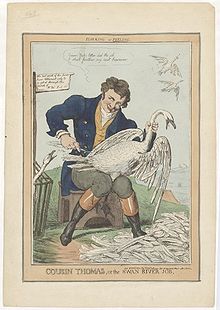Thomas Peel


Mr. Peel, he moans, took him from England to Swan River, West Australia, means of subsistence and of production to the amount of £50,000. Mr. Peel had the foresight to bring with him, besides, 300 persons of the working-class, men, women, and children. Once arrived at his destination, "Mr. Peel was left without a servant to make his bed or fetch him water from the river." Unhappy Mr. Peel who provided for everything except the export of English modes of production to Swan River. —Karl Marx, Das Kapital, volume one, chapter 33.[1]
Thomas Peel (1795-1865) was one of the very early settlers of Western Australia. He was a second cousin of Sir Robert Peel.
In 1828 Peel and three others including an MP, Potter McQueen, formed a consortium to found a colony at the Swan River in Western Australia by sending settlers there with stock and necessary materials. The consortium requested a grant from the British Colonial Office in London of 4,000,000 acres (16,000 km²). The government declined this and offered a grant of 1,000,000 acres (4,000 km²) on certain conditions.
Early in 1829 all the members of the consortium withdrew except Peel. Fresh conditions were made, the final arrangement being that if Peel landed 400 settlers before November 1, 1829, he would receive 250,000 acres (1,000 km²). If the conditions were fulfilled further grants would be made.
He arrived in Western Australia aboard the Gilmore in December 1829 with 300 settlers. As he had not fulfilled the conditions the grant was no longer reserved for him. The land eventually granted, 250,000 acres (1,000 km²), extended from Cockburn Sound to the Murray River.
The early settlement struggled due to lack of labour and limited good-quality farming land. This, together with Peel's poor organising skills, meant that he was soon in difficulties. Within less than two years he had spent £50,000 and some of his settlers had deserted him. Eventually he discharged all but a few from their indentures. In September 1834, Peel was granted further land, but he had little success in developing it. Some other pioneers (like James Henty) moved to Tasmania and the Port Phillip district.
He died at Mandurah in 1865 in comparatively poor circumstances.
References
Footnotes
- ^ Marx K Das Kapital Relevant page (Google Books)
- Appleyard R T and Manford T The Beginning: European discovery and early settlement of Swan River, Western Australia (University of Western Australia Press, Nedlands 1979) ISBN: 0 85564 146 0
- Hasluck, Alexandra (1965) Thomas Peel of Swan River (Oxford University Press, Melbourne 1965)
- Serle, Percival (1949). "Peel, Thomas". Dictionary of Australian Biography. Sydney: Angus & Robertson.
